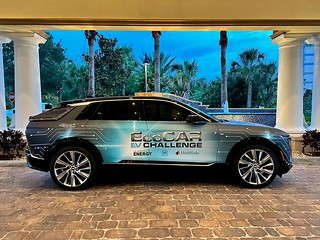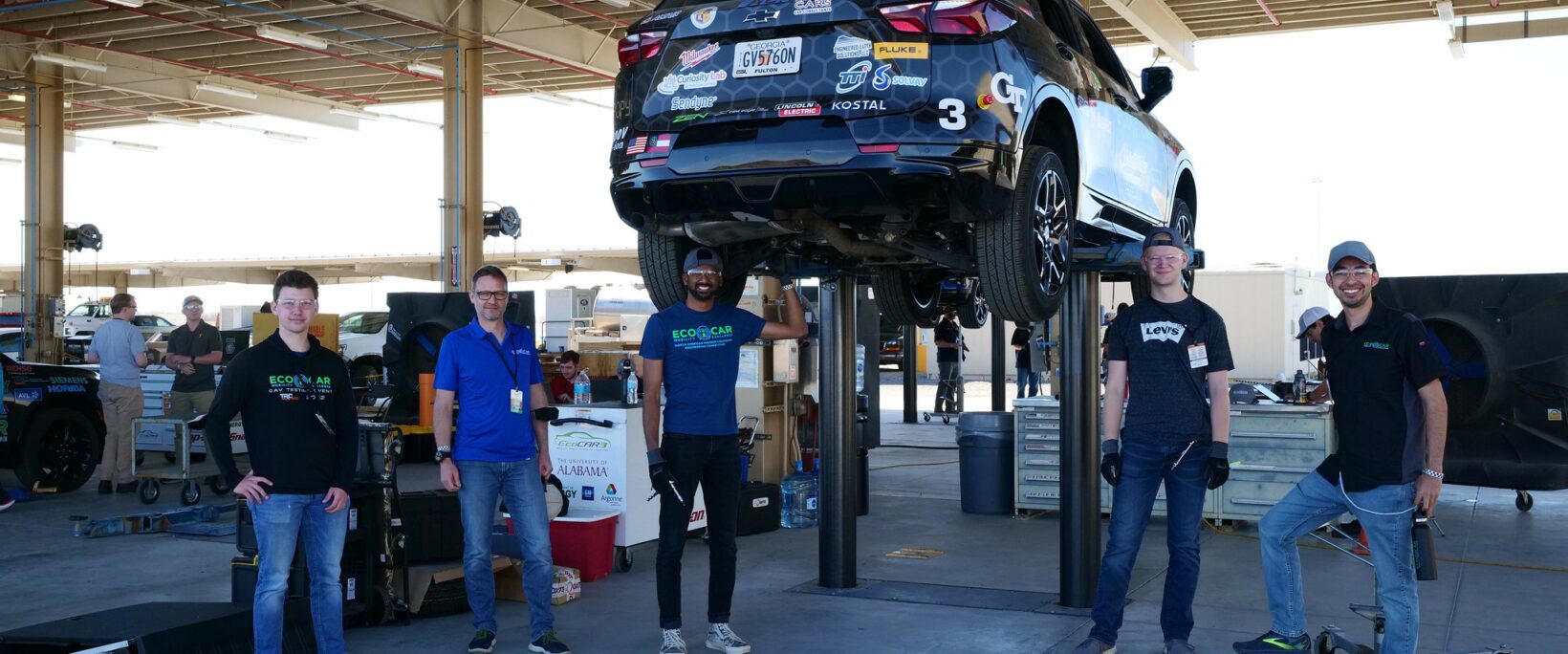
Students
Are you looking to shape the future of mobility? Join EcoCAR!
EcoCAR participants gain technical skills in vehicle design and engineering, as well as soft skills such as teamwork, leadership, project management, and problem-solving. Through involvement in EcoCAR, team members have the opportunity to work on complex, cutting-edge projects and acquire a unique set of skills and competencies that are highly valued in the automotive and tech industries.
Why Join?
A key mission of AVTCs is to provide student enrichment and education through experiential learning and supplemental training. Through EcoCAR, students gain hands-on, real-world experience in the areas of engineering, business, and communications.





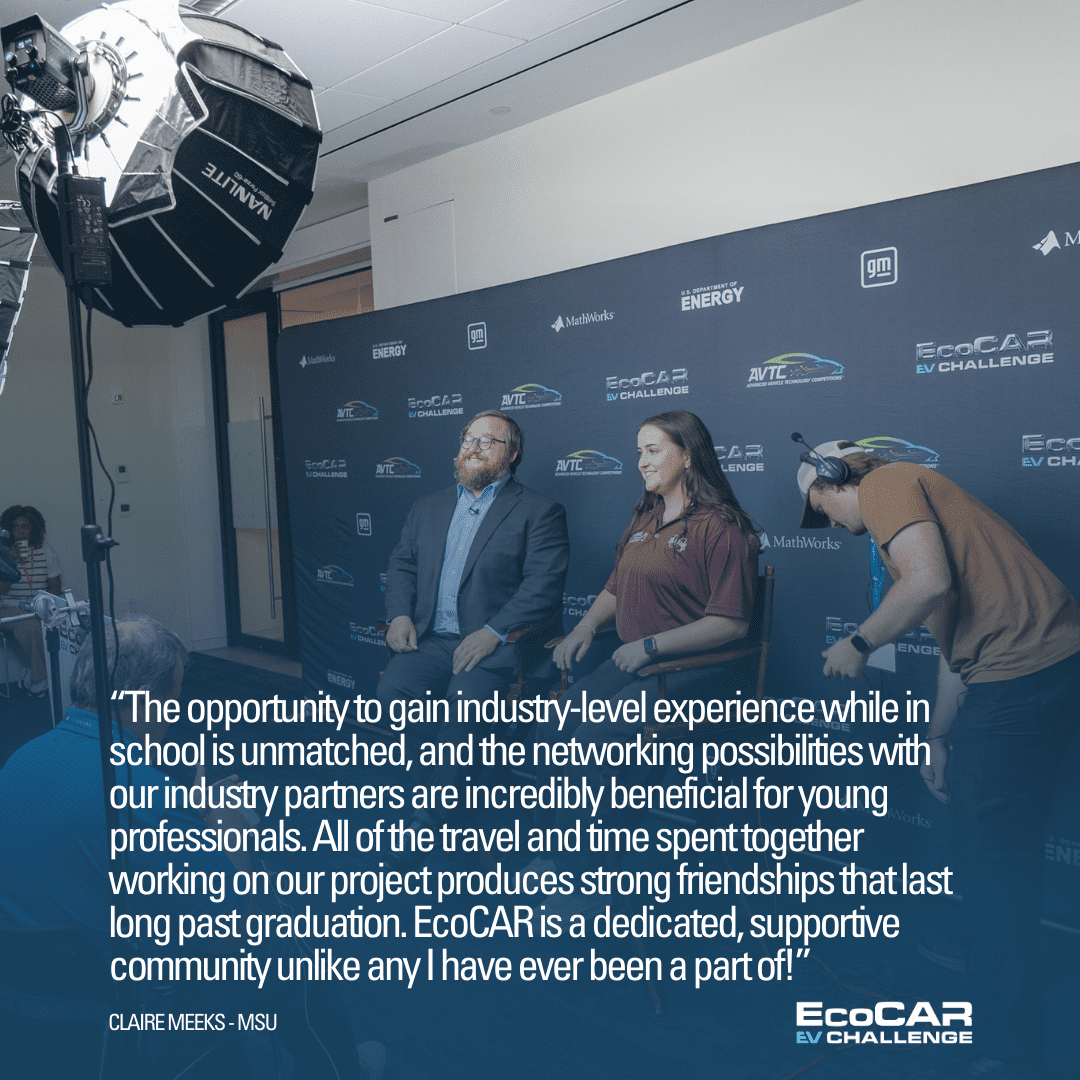
Benefits of Competing in EcoCAR
EcoCAR provides an opportunity for university students to participate in hands-on automotive research and design activities using contemporary industry standards and practices.
EcoCAR Provides:
Real-World Experience
- Participation in a high-profile, hands-on project that mimics an automotive start up environment
- Opportunities to gain real-world leadership skills: teamwork, collaboration, and problem-solving skills; verbal and non-verbal communication; business and communications acumen
Competitive Salaries & Funding
- Top jobs with North America’s premier employers (EcoCAR graduates command higher starting salaries than their peers, $4K-15K/average depending upon degree)
- Funded graduate and undergraduate student support and travel to workshops and competitions
Experimental Learning
- Unparalleled, experiential learning experience for students
- Access to state-of-the-art testing facilities
- Research opportunities and publications
- Experience with a real-world vehicle development process and learn industry best practices, tools, standards and methods to prepare you for future careers in the mobility industry


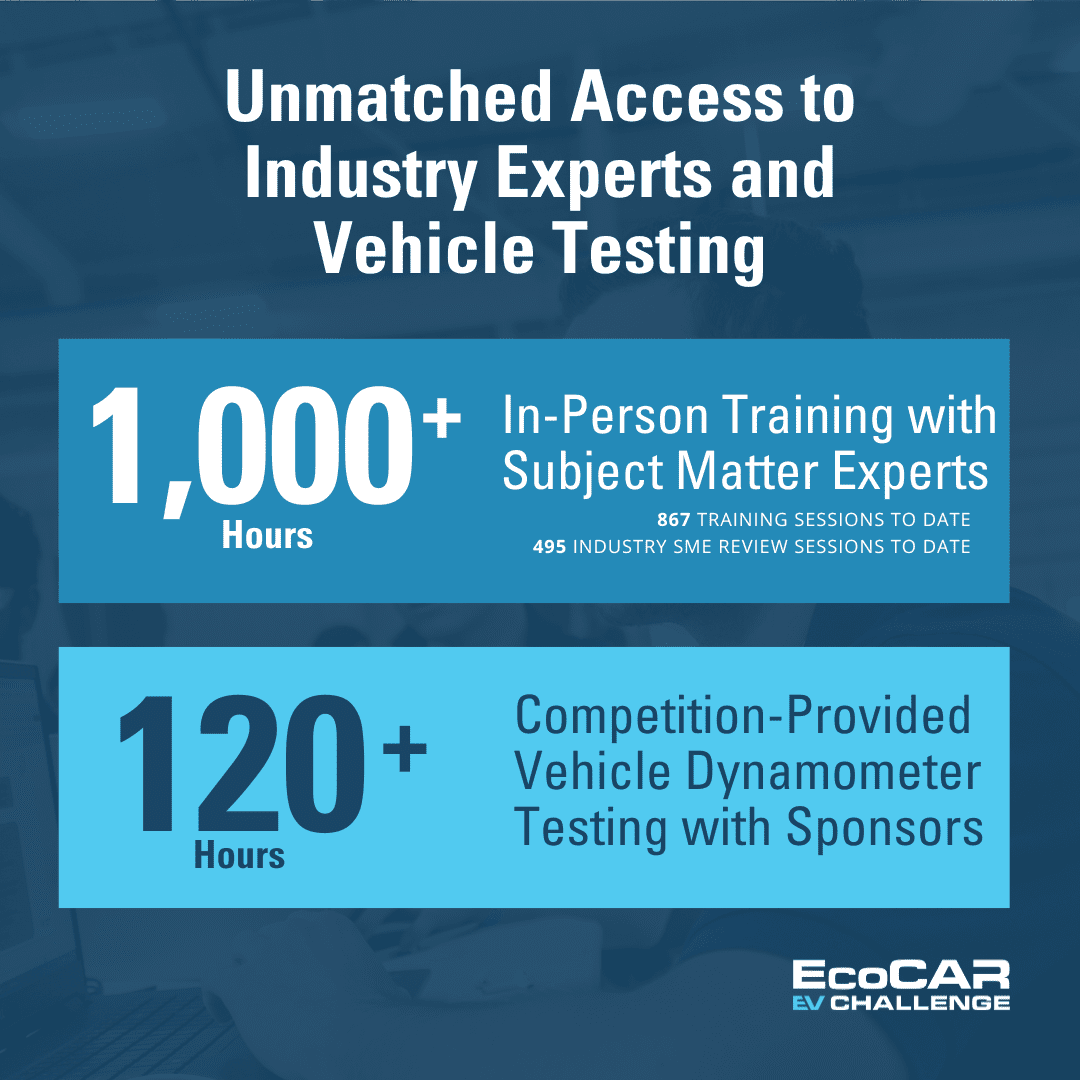
LEARN ABOUT THE SUBTEAMS
With EcoCAR, you are participating in a high-profile, hands-on project where you’re following real-world processes and working in an interdisciplinary environment. This experience fuels your resume to help you get wherever you want to go. With a multi-disciplinary approach, students of all majors are welcome to join the EcoCAR EV Challenge.
Project Management (PM)
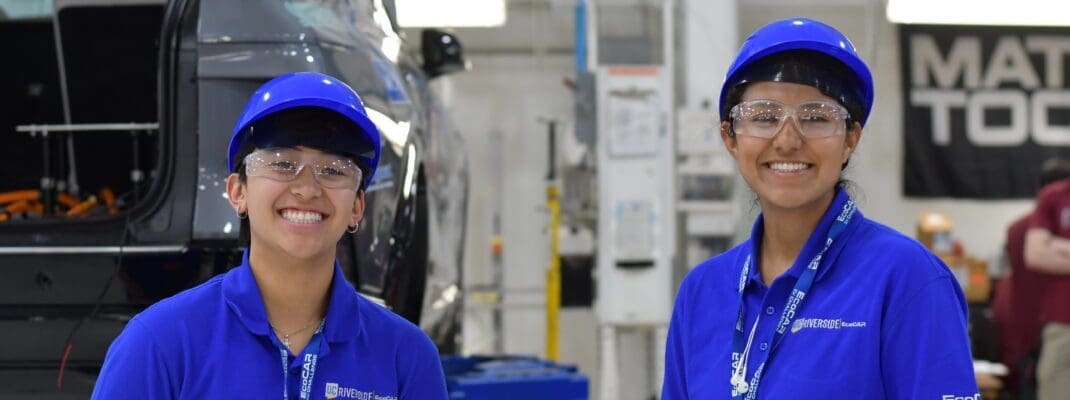
What is it?
EcoCAR Project Managers (PMs) establish how their team operates by defining organizational processes, creating and maintaining execution plans, and coordinating work across all technical and operational functions.
What Do Students Work On?
Serving as the hub of the team, PMs provide cross-functional oversight while also exercising emotional intelligence to motivate peers, manage conflict, and foster effective team dynamics. They monitor progress, mitigate risk, and assert the authority needed to control scope, schedule, resources, and deliverables — ensuring the project advances with both discipline and cohesion.
What's the Importance?
The PM subteam will not only develop the overall project timeline and work plan but is responsible for tracking and executing all project-level activities, knowledge transfer, and recruiting and retention activities.
Skills Gained
- Project Execution and Monitoring
- Agile Management Techniques
- Critical Path Identification
- Conflict Resolution
- Peer-to-Peer Management
- Stakeholder identification and management
- Project Closing: Stakeholder Value Assessment and Justifications
- Project Closing: Team Retrospectives and Program Continuation
Majors
- Graduate Engineering Program (MSME, MSEE, etc.)
- Engineering Management
- Industrial Engineering
- MBAs with an engineering undergrad or dual major
Careers
- Program Managers
- Project Managers
- Senior Leadership
- Engineering Manager
- Operations Analyst
Communications Management (CM)

What is it?
The Communications Management Subteam oversees communications and outreach activities for each individual EcoCAR Team. The Communications Manager (CM) will lead all group activities for this Sub Team.
What Do Students Work On?
Students in the CM subteam will plan and host events, educate local youth grades K-12 on Science Technology Engineering and Math (STEM), and manage all social media efforts. Communications students will gain invaluable experience through these activities that align with industry practices for standard communications programs.
What's the Importance?
The CM subteam will enhance the visibility of Advanced Vehicle Technology Competitions (AVTCs), the EcoCAR EV Challenge and individual EcoCAR teams. This subteam will Promote the benefits of advanced vehicle technologies and highlight team achievements through creative writing/ blogging, social media, and local events.
Skills Gained
- Management and leadership
- Strong presentation skills
- Ability to learn, understand and communicate advanced vehicle technologies
- Public Relations
- Event Planning
- Social Media
- Video Production
Majors
- Various majors and skillsets are welcome to participate in the Communications sub-team!
- Public Relations
- Journalism
- Communication Technology
- Strategic Communication
- Human Communication or Interpersonal Communication
- Digital Media
- Graphic Design (to assist with content and graphic development)
- Education Majors (to assist with youth outreach and activity development)
Careers
- Communications Strategist
- Communications Coordinator
- Social Media Manager
- Event Planner
- Journalist
- Public Relations Specialist
Mobility Challenge (MC)

What is it?
The Mobility Challenge (MC) track of the EcoCAR EV Challenge charges students to learn about mobility, infrastructure, and passenger vehicle design challenges by developing community-engaged and user-centered projects to address these challenges. Students in this area will be developing innovative, user-centered solutions that address current vehicle design gaps, or by working with their local communities to develop innovative mobility solutions.
What Do Students Work On?
Mobility Challenge – Track 1: Community Challenge
- Mobility Challenge: Community Challenge Track teams will be responsible for understanding the needs of their stakeholders (the most influential stakeholder being local community members) to craft mobility/infrastructure solutions that best serve them.
- Mobility Challenge: Community Challenge Trak teams will engage a community-based organization and collaboratively execute a capstone mobility-related activity that results in a tangible and measurable benefit to the stakeholder of interest.
Mobility Challenge – Track 2: Design Challenge
- The Mobility Challenge: Design Challenge will require teams to utilize user-centered design principles to re-engineer passenger vehicle features, components and infrastructure with affordability, efficiency, reliability, and safety for all users at the forefront.
- Students will research vehicle design issues in areas such as human machine interface (HMI), driver monitoring systems, and interior design that exist for vehicle operators. Teams will be focused on developing solutions aligned with the goal of innovative design – to ensure that the population of potential users for a product or service is maximized. Students will conduct market research to understand these challenges and develop system-level requirements for new designs based off consumer insight. They will prototype and iterate new designs based on user feedback, with the potential to integrate these components into the vehicle in Year 4.
What's the Importance?
- The Mobility Challenge track of the EcoCAR competition charges students to learn about mobility, infrastructure, and passenger vehicle design challenges by developing community-engaged and user-centered projects to address these challenges.
- The main goals of the program are to educate EcoCAR students on the importance of innovation in mobility by (1) equipping students with the ability to problem solve; (2) bringing awareness to design gaps and mobility within local communities, and; (3) reinforcing importance of stakeholder-centered design to develop innovative solutions for mobility challenges.
Skills Gained
- Problem solving
- Written & verbal communication
- Data collection and analysis
- Ability to distill technical concepts into digestible content for different audiences
Majors
All majors and skillsets are welcome to participate in the Mobility Challenge Subteam! To be successful in this subteam, you will need a range of perspectives from many different majors including those not pursuing careers in STEM.
Non-Engineering Majors strategically beneficial for the track:
- Psychology
- Industrial Psychology
- Human Factors & Ergonomics
- Political Science
- Anthropology
- Public Policy
- Public Administration
- City & Regional Planning
Careers
Potential Careers Opportunities:
- Any position where you work with or lead a team of individuals
- Additional Roles (If you need specifics):
- Program Manager
- Project Manager
- City & Regional Planners
- Any engineering careers
- Researcher at the National Laboratories like Argonne
Connected and Automated Vehicle (CAV)

What is it?
The Connected and Automated Vehicle (CAV) subteam will be a multidisciplinary group of students leading the development of the connected and automated driving features. The features will include connected adaptive cruise control, automatic lane centering, traversing connected corridors, and optimizing vehicle controls for energy efficiency.
What Do Students Work On?
The CAV subteam goal is to design, build, and deploy automated driving features on their team's Cadillac LYRIQ. These features will not only be functional and safe but will also improve the vehicle's energy consumption.
The CAVs students will develop and deploy CACC, develop and refine Lateral Feature Functionality and refine Longitudinal Control ([C]ACC/AIN) for Energy Consumption and Drive Quality events.
What's the Importance?
Connected and Automated Vehicles have the capability to vastly improve the efficiency of transportation, reduce congestion, and completely eliminate accidents. Since this technology is still in development, the CAV subteam in EVC will directly contribute to making CAVs become a reality in our world in the near-future.
Skills Gained
- Software Development
- Autonomous Controls Deployment
- Perception System Design and Implementation
- Programming / Code development
- RTMaps
- Computer vision
- Sensor data processing
- Machine Learning / Artificial Intelligence
- Software Development
- Sensor fusion
- Modelling and simulation
- Git
- Sensor Integration
- CAN communications
Majors
- Electrical Engineering
- Computer Engineering
- Computer Science
- Mechanical Engineering
Careers
Potential Careers Opportunities:
- Software Engineer
- Software Developer
- Controls Engineer
- Computer Vision Engineer
- Machine Learning Engineer
- Data Scientist
- Autonomous Systems Engineer
- Robotics Engineer
Propulsion Controls and Modeling (PCM)

What is it?
The Propulsion Controls and Modelling (PCM) subteam is responsible for the design, development, integration and testing of the longitudinal propulsion controls on the vehicle. The controls development process involves using software development and modeling techniques to design a system that is optimized for performance and energy efficiency.
What Do Students Work On?
Students will be working in MATLAB/Simulink to design their propulsion controls algorithm and how it interfaces with the rest of the vehicle. They will also model their controls system performance using model-in-the-loop and hardware-in-the-loop testing, before eventually engaging in vehicle testing to evaluate performance.
What's the Importance?
Propulsion controls is crucial to the vehicle in that it controls all of the devices that put torque to the wheels. Not only does the PCM team design a system that can efficiently drive the vehicle but establishes the interfaces for how other systems other than the driver (ie. CAVs) may command torque.
Skills Gained
- MATLAB/Simulink
- Refine propulsion controls (torque control and driveability software)
- Develop robust diagnostic software
- Develop one pedal drive software
- Software development processes
- Simulation based testing
- Vehicle based testing
- Data processing
Majors
- Mechanical Engineering
- Electrical Engineering
- Computer Science
- Computer Engineering
Careers
Potential Careers Opportunities:
- Controls Engineer (not just automotive, controls is everywhere!)
- Software Engineer
- Calibration Engineer
- Test Engineer
- Modeling and Simulation Engineer
- Scripting and Tools Developer
System Design and Integration (SDI)

What is it?
The mission of the System Design and Integration (SDI) Subteam is to design, integrate, evaluate, and refine all vehicle systems and components, including Connected and Automated Vehicle (CAV), Propulsion Controls and Modeling (PCM), electrical, thermal, and mechanical, to ensure the vehicle safely functions as designed.
What Do Students Work On?
The SDI subteams will follow an iterative design process, exploring different material properties, packaging, and wire routing strategies to achieve the desired safety, operation, and serviceability for their team design components.
What's the Importance?
The SDI subteam works with the PCM and CAV subteams to establish component and system requirements ensuring that the components selected for their vehicle architecture not only meet their vehicle targets in simulation, but can be effectively packaged, powered, and monitored in the competition donated Cadillac LYRIQ.
The SDI subteam has a large role and emphasis in Years 1 and 2 of the competition when component packaging, electrical schematic and diagram planning, and thermal system design are core development tasks. In Years 3 and 4, the SDI subteam will have a minimal role in core development tasks as the focus is more on vehicle level refinement and calibration activities.
Skills Gained
- CAD Space Claim and Component Packaging
- Component Mount Design and Manufacture
- Structural Analysis
- Mass Management and Light-Weighting
- Power Distribution
- High-Voltage and Low-Voltage System Design and Integration
- Thermal System Design and Integration
- Vehicle Dynamics
- Data Automation & Analysis
- Vehicle Drivability Optimization
- Vehicle Test Planning & Execution
Majors
- Mechanical Engineering
- Electrical Engineering
- Industrial Engineering
- Graduate Engineering Program (MSME, MSEE, etc.)
Careers
Potential Careers Opportunities
- Structural Engineer
- Automotive Engineer
- Vehicle Calibrator
- Product Designer
